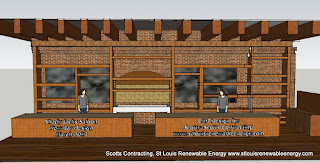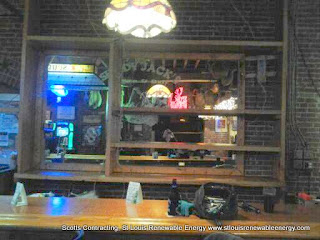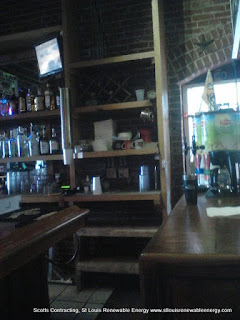strongly urges you the reader to read between the lines on this article. Especially since the interview seems to be based on: Fossil Fuel Supporters
Brayton Point Power Station in Somerset, Massachusetts (Mr. Ducke/flickr)
Introduction
Over the past 250 years, we have become increasingly reliant on fossil fuels. Coal, oil and natural gas powered the industrial and technological revolutions and to this day remain the world’s most dominant source of energy.
But when fossil fuels are burned to create energy, they release carbon dioxide into the atmosphere which contributes to global warming. Indeed, fossil fuels produce the majority of the world’s greenhouse gases and are a huge driver of climate change. Stocks are also far from infinite. Aside from the environmental concerns, we will eventually run out.
Our dependence is causing us problems — and it needs to be addressed immediately.
Utility executive Mike Jesanis, Boston University professor Cutler Cleveland and environmental attorney N. Jonathan Peress discuss the future of fossil fuels.
The former president and CEO of National Grid USA, Mike Jesanis is an adviser to companies, governments, and non-profits in traditional and emerging energy fields.
After the oil embargoes of 1970s, New England Electric System (NEES) converted six of its eight large oil-fired plants to coal and bought a coal-fired ship to supply them. For this decision — along with energy efficiency investments — NEES won national acclaim for its bold, forward-thinking business strategy. When deregulation hit the oil and natural gas industries in the mid-1980s, prices for those fuels plummeted, and those of us at NEES saw our bold, forward-thinking investments lose half their value, virtually overnight.
That early experience taught me a valuable lesson: Disruptive change in the energy industry is primarily driven by economics. Political and environmental events such as the 2003 East Coast blackout, or hurricanes like Katrina and Sandy may temporarily garner headlines, but they tend not to result in major changes.
What we’ve seen in recent years is a confluence of factors — primarily, improved technology for horizontal drilling and for hydraulic fracking — that has led to a substantial increase in production and a decrease in the price of natural gas from shale.
Disruptive change in the energy industry is primarily driven by economics. Political and environmental events such as the 2003 East Coast blackout, or hurricanes like Katrina and Sandy may temporarily garner headlines, but they tend not to result in major changes.
From 1970 to 1990, natural gas reserves in the U.S. fell by half. In the last 5 to8 years, all of those reserves have been replenished thanks to new, improved technologies. Industry estimates now project that the U.S. has at least 100 years worth of natural gas reserves, and that within 20 years half of U.S. natural gas production will be from shale. Put simply, large quantities of cheap, available natural gas from shale is a game-changer for the U.S. energy industry.
The first loser in this new marketplace is nuclear power. Exelon, the nation’s premiere nuclear power plant operator, has lost about two-thirds of its market value since 2008. The second loser is coal. Coal plants simply can’t compete with natural gas, both in New England and across the country. PJM, the power grid system operator for the mid-Atlantic region, just announced that it is retiring the equivalent of 15,000 megawatts of coal-fired power plants. Environmentalists and the EPA tried for decades, and failed to shut down many of those plants. Natural gas got it done.
New energy technologies — whether nuclear, wind, biomass or solar — are also losers. Because those technologies are now competing against cheap, plentiful natural gas — which is both more economical and less of an environmental issue than coal — the premium paid to adopt those energy sources just got higher.
Low-cost natural gas produces winners, too. According to ISO New England, natural gas now effectively sets the price for electricity generation in the region. With the fall in natural gas prices, since 2008 that has resulted in savings of $7 billion for New England electricity consumers.
Residential customers aren’t the only beneficiaries. Low natural gas prices are now spurring petrochemical companies like the Dow Chemical Company to reinvest in the their domestic research, development and production operations. PwC estimates 1 million U.S. manufacturing jobs will be created in the next decade because of the impact of low natural gas prices.
Pipeline companies, like the company on whose board I sit, also benefit from the boom in natural gas. They are not only laying new pipe; they’re repairing and replacing older pipelines that are more prone to economically wasteful and environmentally damaging leaks.
I don’t think we can imagine all the ways our energy future will change in the coming decades. There’s going to be some development in technology or in markets that will be a game-changer for how we generate and use energy. But for now, increased use of natural gas is the dominant factor changing our energy markets.
Editor-in-chief of the Encyclopedia of Energy, Cutler Clevelandis a professor in the department of Earth and Environment at Boston University, and a senior fellow at the National Council for Science and the Environment in Washington D.C., where he serves on the executive board of the Council of Energy Research and Education Leaders (CEREL).
I’m not pro-fossil fuels or anti-fossil fuels, but the consequence of burning fossil fuels has enormous implications for future generations, and I think that has to be front and center in our discussion about what we do with these resources.
There’s a lot of fossil fuel left in the earth’s crust. My estimate, based on a variety of respected sources, is that at current global rates of use, there’s over 1,200 years worth of oil, natural gas and coal that is “technically recoverable” — meaning, we can extract and process it using currently or near-currently available technologies.
What would that mean for the Earth’s atmosphere?
No president since Jimmy Carter has dared talk with the American people about our use of energy. How, and how efficiently, we use energy has to be part of the discussion.
Well, the total carbon content of those fossil fuels is almost 15,000 petagrams (1 petagram equals 1 billion metric tons). Most of that is in coal, but a fair amount is in oil and natural gas, too. By way of comparison, we’ve produced a total of 346 petagrams of carbon emissions worldwide since 1751. If we put anywhere near that amount of carbon into the atmosphere, we’ll fundamentally alter the planet’s climate system in ways that make the 1 or 2 degree rise of the last century seem almost laughably trivial.
What has to happen to prevent all this carbon from entering the atmosphere? We have to start using non-carbon fuels. And here there’s good news.
According to the IPCC, renewable sources of energy — wind, biomass, hydro, geothermal, and especially solar — have the potential to meet and far exceed global electricity demand, both now and in the future.
We face significant barriers in building a low-carbon, renewable energy future. First, there are the enormous — and growing — sunk costs in fossil fuel infrastructure. Second, major energy transitions — from wood to coal, from coal to oil — historically take 30 or more years.
Another major problem is the market sends perverse signals about energy. The environmental and human health externalities — costs not reflected in the price — associated with fossil fuels are staggeringly large. In
the case of coal, they exceed the market price. Market signals have to be altered if we want to change this.
The cost of renewables remains a significant barrier to their adoption. Wind power’s cost is 50 percent higher than combined-cycle natural gas plants. Solar is twice as expensive right now, even though its costs have come way down in the last 20 years. The transition to a green energy future will not be cost free.
Fifteen of the 20 largest corporations in the world sell carbon. Just as tobacco companies spent decades denying the fact that smoking causes lung cancer, these companies have worked furiously to deny the reality of climate change.
Finally, there’s the third rail of American energy politics — the demand side. No president since Jimmy Carter has dared talk with the American people about our use of energy. How, and how efficiently, we use energy has to be part of the discussion.
This is the pre-eminent question we face as a species. And the skids are greased to keep pulling fossil fuels out of the earth’s crust. We have the infrastructure in place to continue burning it. If we’re really concerned about climate, then the changes we need to make will require a level of disruption that makes the shale gas revolution seem tame.
To get serious about climate change requires radical, disruptive change that fundamentally alters the trajectory of human civilization from its present course. That kind of change
is possible. The
eradication of smallpox, the
Green Revolution, and the
Manhattan Project are just a few recent examples. But it requires a determined, sustained commitment to make it happen.
N. Jonathan Peress is vice president of the Conservation Law Foundation and director of CLF’s clean energy and climate change program.
According to power grid system operator ISO New England, natural gas produced 15 percent of the electricity in New England in 2000. In 2011, natural gas produced 51 percent of the region’s electricity. The rapid growth in market share for natural gas displaced coal and oil power plants. It also helps keep wind, solar and other renewables confined to a small share of the energy market.
This highlights the paradoxical role of natural gas: It’s helping to reduce current carbon emissions in our electric system, while simultaneously delaying our ability to deploy renewable energy sources to reduce future carbon emissions. Natural gas may be on the right side of the “carbon curve” today, but it will be on the wrong side very quickly.
Under existing law, Massachusetts greenhouse gas emissions in the energy system are
scheduled to drop 80 percent by 2050. LINK There’s no way– or at least, no known way– to achieve that goal with natural gas as the primary fuel powering our electrical system.
Natural gas is helping to reduce current carbon emissions in our electric system, while simultaneously delaying our ability to deploy renewable energy sources to reduce future carbon emissions.
Traditional analysis shows that natural gas plants are cleaner than oil or coal plants. For example, a typical gas-fired plant releases approximately half as much carbon dioxide into the atmosphere as a coal-fired plant.
However, recent life-cycle analysis suggests that reductions in greenhouse gas emissions from natural gas
are minimal. A recent
study by the National Center for Atmospheric Research concluded “substitution of gas for coal as an energy source results in increased rather than decreased global warming for many decades.”
One of the big issues in that regard is leakage. We actually don’t know how much gas we lose in the system. Cornell Professor Robert Howarth
estimates that 3.6 to 7.9 percent of methane is lost through leaks and flaring at the production stage. At the local distribution level, gas companies are compensated for what’s called “lost and unaccounted-for gas,” which can amount to as much as 10 to 12 percent of the natural gas a company brings into the system.
The bottom line is this: Unless leakage rates for new methane can be kept below 2 percent on a life-cycle basis, substituting gas for coal is not an effective way to reduce the magnitude of future climate change.
In the near term, natural gas plays an important role in retiring the dirty, obsolete coal-fired power plants the country has relied on for the last 40 years. But at the Conservation Law Foundation, we think any new fossil fuel investment must be rigorously scrutinized to determine how it will fit in with climate mandates and market realities of the future. New power plants typically run for 30 to 40 years, and new pipelines can last for 80 to 100 years.
In our view, it doesn’t make sense — economically or environmentally — to invest in building new natural gas pipelines and power plants that will be shut down in 10-20 years as we complete the transition to a low-carbon energy future.
There is a more limited role for natural gas to play in future as we decarbonize the power system. The European Climate Foundation concluded that as more variable energy resources (i.e. wind and solar) come online, there needs to be some sort of “firming resource” — power sources that can quickly and reliably be turned on and off — in the system. That’s a role natural gas (and hydropower) can play when the wind stops blowing and the sun isn’t shining brightly.
New England should invest more heavily in energy efficiency, and in repairing leaks and inefficiencies in existing gas pipelines, while also structuring its energy markets, including the services offered in the gas markets, to help spur development of the low-carbon energy system we want and need for the mid-21st century.
Thank you for stopping by St Louis Renewable Energy. Feel free to comment in the section below or contact Scotts Contracting- St Louis Home Improvement Projects and Energy Reducing Needs






.jpg)


